What is compression therapy?
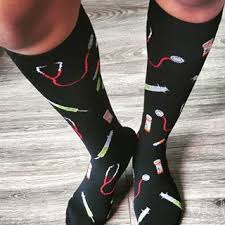
In the 21st century, it is common to hear a few terms that are related to diseases and treatments. One of the most common terms you will come across is compression therapy. Compression therapy has become very popular in the last few years, thanks to how affordable it is, and how it can be used under no supervision to manage symptoms.
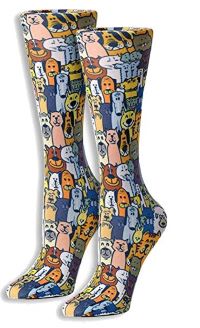
So what is compression therapy? Compression therapy is a form of treatment or therapy, as the name suggests, where you apply external pressure on certain parts of the body using some sort of clothing. Compression therapy means using clothing to squeeze or compress the tissues that form your body parts.
Compression therapy is mostly used on the legs. In rare cases, you will find people applying compression on their arms, but it is prevalent to find people using compression therapy on their legs, ankles, and feet. At the gym, you will see people with brightly colored socks during their leg exercises. Marathon runners can also be seen sporting these socks, as do nurses, teachers, pilots, regular travelers, and people who generally have tired feet.
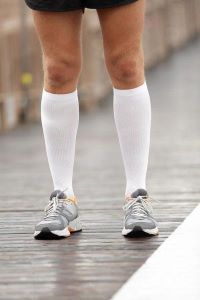
Many people think that compression therapy is only for senior people, but this is not true. The concept of compression therapy is the external application of a controlled pressure to an extremity to help increase the efficiency of venous and lymphatic systems. Both of these systems require improvement in both younger and older people.

Venous Systems
The venous system is the part of circulation that is responsible for transporting blood from the periphery to the heart. There are two parts of venous systems; the superficial venous systems, and deep venous systems. Superficial venous systems transport blood from the surface of the skin (skin and subcutaneous tissues) and collect it in the deep veins.
Deep veins are more rooted in the body and generally run parallel to the corresponding arteries. The two types of venous systems are separated from each other by connective tissue and muscle but are also connected by smaller venous systems known as the perforating veins, or communicating veins.

The walls of the veins are thinner than those of the arteries. The arteries are responsible for transporting blood from the heart to other parts of the body. They have muscular walls that help with the process of circulation; veins do not have these. Instead, veins have crescent-shaped valves that divide the long vessels into segments.
These valves open when blood is pushed upwards towards the center of the body and against gravity. They then close when the blood comes to a standstill and would start to flow backward. This closing of the valves prevents the backflow of blood and prevents pooling at the ankles and feet.
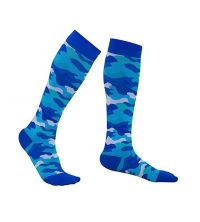
Physical activities keep the veins on the move. When we contract our muscles to walk, they squeeze the veins together. This contraction pumps blood out of the calves into the heart and is where the term ‘calf muscle pump’ is derived. After contraction, the pressure in the emptied veins drops, leaving room for more blood to come in. The pressure drop explains why exercise is vital for vein health.

Without physical exercise, the muscles cannot exert mechanical pressure on the veins, which can then become distended. A lack of activity prevents the valves inside from closing correctly after they open. Because of this, blood pools in the veins, and because muscles do not stabilize them, they become dilated.
This condition manifests itself as tired and heavy legs. There will also visible swelling that may cause pain. You may even notice a web of visible veins that are discolored; these are known as spider veins. The veins can also become swollen, bulging, twisted, discolored, and painful, a condition known as varicose veins.
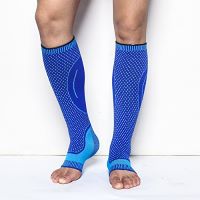
When this happens, compression therapy proves to be more than useful. Compression wear offers graduated pressure that reduces the diameter of the veins. A reduced diameter enables the valves inside the veins to open and then close again to transport blood faster to the heart.

Compression wear ensures that blood does not stop flowing, and reduces the amount of blood that flows backward. Compression socks reduce the appearance of varicose veins and spider veins. And compression therapy reduces swelling in the legs and will eliminate pain.
Going even further, foot compression may be what stands in the way of developing a fatal condition known as Pulmonary Embolism. When blood slows down in the deep veins of the body, it increases the chances of forming clots within the veins. When a clot or two forms, it causes pain, swelling, discoloration, and cramping at the point where the clot formed. It occurs typically in the thigh and the lower leg and is known as deep vein thrombosis.

When a piece of the clot breaks off and joins the bloodstream, it travels to the lungs and may enter the arteries, causing a blockage. When this happens, the condition turns to what is known as pulmonary embolism. Symptoms of this condition include a shortage of breath suddenly, and pain in the chest when breathing in and when coughing. You will also experience discomfort when walking and may cough up blood in progressed conditions.

Unfortunately, many people do not realize that they have deep veins thrombosis until they get symptoms of pulmonary embolism. Compression therapy can also help with symptoms of deep vein thrombosis. When worn early enough, compression garments prevents the breaking of a piece of the blood clot. They do this by ensuring that blood does not stagnate any further, and instead, circulation goes on. And the flow of blood puts you at less risk of developing pulmonary embolism.
Lymphatic Systems

The lymphatic system is an extensive network of vessels that passes through almost every tissue in the body. They allow the movement of a fluid known as lymph, which circulates the body just as blood does. It plays a crucial role in the immune system, fluid balance, and the absorption of fats and fat-soluble nutrients. More than that, the lymphatic system maintains the balance of fluid between the blood and the tissues known as homeostasis.
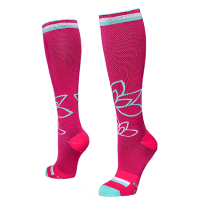
Like every other system in the body, the lymphatic system can become infected or damaged. Though it is essential in fighting disease, it can get infected or injured, causing an imbalance in the body. Lymphatic dysfunction or lymphedema means that the system is not working correctly.
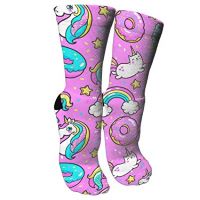
A poorly working lymphatic system causes tissues to be swollen with fluid; this is what is called lymphedema, and it is relatively common among people of all ages due to several reasons. Swelling often occurs in the arms and the legs but more commonly in the legs. You can be born with lymphedema; it is called hereditary lymphedema, or primary lymphedema. You can also develop lymphedema from a complication, disease, or injury. It is called secondary lymphedema.
Hereditary or primary lymphedema is less common than secondary; it affects those who have family members with lymphedema. It can manifest as Milroy disease, a condition that causes the structures that make up your lymphatic system to form incorrectly.

Secondary lymphedema is more common and is caused by cancer and radiotherapy. Tumors and scar tissue from radiation and surgery can lead to damage and injury to the lymphatic system. It can also occur after the treatment of cancers of the head and neck that can lead to swelling of the face and eyes.

The main symptom of both these conditions is swelling in the arms, legs, fingers, and toes. The swelling affects the limbs (mostly legs), which lead to heaviness and a limited range of motion. On the skin, you will see discoloration, blisters, changes in texture, infection, and leaking of fluid.
Lymphedema is classified into stages that are based on the severity of the condition. The first stage is Stage 0 (latent); here, there are no visible changes, but you will notice a sensation that comes with tightness and achiness in the legs. Many people overlook this symptom because it is not completely clear what the problem may be.
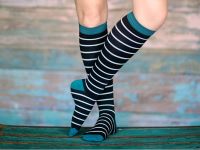
Stage 1 (mild) is the next, and it presents itself as swelling of the legs and feet, which is known as edema. The tissues of the affected area will hold an indentation when you press on them. This is what is known as edema pitting. Still, during this stage, there are no permanent changes on the skin.

Stage 2 (moderate) is where there is an irreversible swelling in the affected areas. The tissues feel spongy to the touch with pitting still occurring. There is severe inflammation, and the skin begins to thicken and tighten. The last stage is Stage 3 (severe); there is ongoing fluid retention in this stage. The affected area hardens and becomes very large. Here the skin changes are permanent, and you may lose function in your limb.
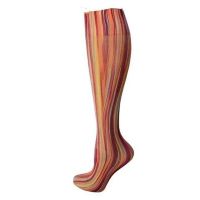
Treatment for this condition is compression therapy, specially designed garments that have a snug fit over the swollen limb. Compression socks squeeze the lymphatic vessels, which force out the buildup of liquid in the tissues. Through compression wear, lymph flows as it should, and the muscles release any retained fluid.

People who use compression to treat this issue notice a significant reduction in swelling and tightness around the skin. The pain will also fluctuate with time, and the skin will go back to its normal texture and color if they are worn during the early stages of lymphedema.
Foot Compression Levels
Compression garments are very popular in the market and are made for people with venous disorders and lymphatic problems. The classification of compression garments depends on the aspect you are looking at. It can be styles, fabric, levels of compression, and even where and how they are bought. The most common is the levels of compression.
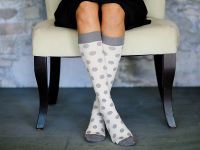
Compression socks come in five primary levels of compression. The level of compression is measured in milligrams of mercury that are written as mmHg. The first level of compression is 8-15 mmHg; it is commonly used by people who travel, a lot, teachers, and people who want to relieve their legs.
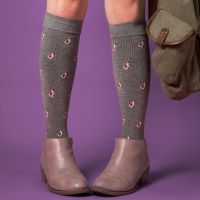
This level of compression provides relief and minimizes tired achy legs. They prevent fatigue in the legs after long periods of sitting or standing; hence they are used by teachers and nurses. They help relieve mild swelling of legs and ankles. During pregnancy, these socks help prevent the formation of spider veins and varicose veins. You can also wear these socks to maintain healthily and energized legs.
Medium compression is 15-20 mmHg compression socks. They are used for the prevention and relief of minor to moderate varicose veins and spider veins. They relieve tired achy legs, swelling of feet and ankles. If you are at risk of developing deep vein thrombosis, then this level of compression is best for you. They are also used in the treatment of post-sclerotherapy to prevent the reemergence of varicose veins. This is the ideal compression for those traveling long distances.
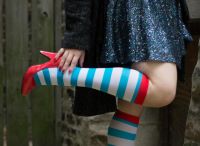
Compression of 20-30 mmHg offers firm density to wearers. They help prevent and relieve moderate to severe symptoms of varicose veins. Pregnant women can also wear them. They help yo treat moderate to severe symptoms of lymphatic edema and relieve superficial thrombophlebitis. This level of compression prevents the formation of deep vein thrombosis if they are worn early enough. They also prevent orthostatic hypotension, a condition characterized by a sudden fall in blood pressure.
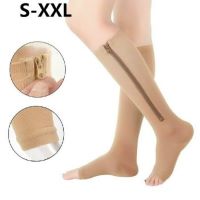

Extra firm compression is 30-40 mmHg; it is used to prevent and relieve symptoms of severe varicose veins. They are also used in the treatment of severe edema and in post-surgical treatment to ensure circulation is just as regular. It helps to reduce the symptoms of Orthostatic Hypotension and Postural Hypotension. They can also be used in the management of Venous Ulcers. Moreover, they are essential in treating the manifestations of Post-Thrombotic Syndrome (PTS).
Finally, the largest and highest level of compression socks is the 40-50 mmHg. This type of compression is not found over the counter because only a doctor can recommend it. This level of compression should never be worn unless insisted by a doctor. This is because they offer extra firm compression that is used to treat more severe venous conditions, including acute deep vein thrombosis, extreme varicose veins, and chronic vein insufficiency.
Popular Articles on ComproGear
- Best Compression Socks for Sitting All Day https://comprogear.com/best-compression-socks-for-sitting-all-day/
- Compression Socks for Swollen Ankles https://comprogear.com/compression-socks-for-ankle-swelling/
- Best Compression Socks for Nurses https://comprogear.com/compression-socks-for-nurses/
- Medical Socks for Swollen Feet https://comprogear.com/compression-socks-for-swollen-feet/
- Compression Socks for Above The Knee https://comprogear.com/over-the-knee-compression-socks/
- Compression Stockings Pressure Guide https://comprogear.com/compression-stockings-mmhg-chart/
- Socks for Gout https://comprogear.com/compression-socks-for-gout/
These levels of compression come in many different styles, with the three most popular being knee-high compression socks, full-length hose, and thigh-high compression socks. These have variations such as footless, toeless, zippered, and even heelless. Our compression socks come in knee-high footed styles that are perfect for both the cold and hot seasons.


Compression socks are known to be dull-colored and flesh-toned. However, this has drastically changed as we offer compression socks in fun, relevant colors. We have a variety of colorful, patterned, and cutely themed socks. More than that, our compression socks are made of different materials.
Cotton is relatively conventional for compression socks because it is a natural fiber that is ideal for hot months. It lets in air quickly and wicks away excess moisture for your skin. Micro-fiber is another great fabric for compression socks. It is soft, stretchy, and breathable. It is also thinner, making it suitable for summer.
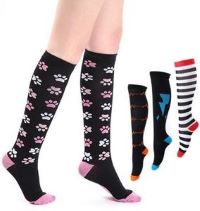
Sheer fabric is the best for summer because it is light, thin, and very breathable. Sheer styles are often used for full-length hose and frequently used by people who like an invisible compression garment. It’s an excellent fabric to wear under work clothes because it is discreet and available in a tone to match your skin. Moreover, it will not pose any additional heat.
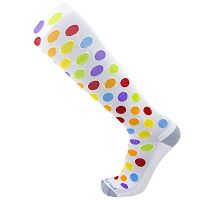
This page last updated November 6, 2022
